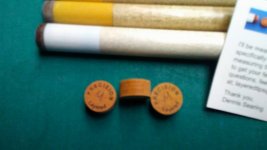I like the dime shape.......
I had a tip put on by a guy not too long ago. It looked pretty flat to me. Flatter than I like. About like a nickle or maybe a little bit flatter.
I've heard from different cue tip guys that you want to have the Kamui a little flatter. I don't know if they were just told this and believed it or they have actually tried playing with them both ways and didn't see any difference.
And then if you just hit center ball mostly you might not see any difference. Or if his skill level is limited he really can't tell the difference.
The same guy that put the tip on for me was at the poolroom I was at watching me play some $100 sets. I was having trouble moving the cue ball around and missed some shots because I did't get the spin I wanted on the cue ball. Tip was too flat.
I got my sand paper and wood block out and started sanding. He came running over to tell me I shouldn't sand on the Kamui. I told him that I knew that but I couldn't play with it as flat as it was. I knew what I was doing I told him.
It played just fine after that.
When shaping the Kamui I use 400 and take it real easy. Works well. Don't use anything coarser. They will delaminate so I've been told. I've always used 400 grit to shape all my tips. With 400 your fine as far as I can see. At least it doesn't hurt mine.
Every once in a while my tip will seem to be a little unresponsive. it's usually because the tip has flattened out a little bit.
If shaping it a little doesn't do it I put on another great SS kamui tan.
I can't imagine playing in a tournament or gambling and not getting the response you want from the tip and being afraid to sand on it a little to get the shape that works the best for yourself.
Common sense would tell you if you are hitting the ball with english, the flat tip has a smaller area of the leather touching the cue ball.
That's why you can get that touchy, feely English easier with the dime shaped tip. More tip surface touching the cue ball.
Again if you play mostly hitting center ball you wouldn't know the difference and it shouldn't matter as much.
Just my opinion from my experience with the Kamui tip only.
I used other layered tips and they were a mess as far as I was concerned. I couldn't figure out how to keep them right.
Kamui has it right.
What is better then the other and why do you think that?? Thanks
AD
I had a tip put on by a guy not too long ago. It looked pretty flat to me. Flatter than I like. About like a nickle or maybe a little bit flatter.
I've heard from different cue tip guys that you want to have the Kamui a little flatter. I don't know if they were just told this and believed it or they have actually tried playing with them both ways and didn't see any difference.
And then if you just hit center ball mostly you might not see any difference. Or if his skill level is limited he really can't tell the difference.
The same guy that put the tip on for me was at the poolroom I was at watching me play some $100 sets. I was having trouble moving the cue ball around and missed some shots because I did't get the spin I wanted on the cue ball. Tip was too flat.
I got my sand paper and wood block out and started sanding. He came running over to tell me I shouldn't sand on the Kamui. I told him that I knew that but I couldn't play with it as flat as it was. I knew what I was doing I told him.
It played just fine after that.
When shaping the Kamui I use 400 and take it real easy. Works well. Don't use anything coarser. They will delaminate so I've been told. I've always used 400 grit to shape all my tips. With 400 your fine as far as I can see. At least it doesn't hurt mine.
Every once in a while my tip will seem to be a little unresponsive. it's usually because the tip has flattened out a little bit.
If shaping it a little doesn't do it I put on another great SS kamui tan.
I can't imagine playing in a tournament or gambling and not getting the response you want from the tip and being afraid to sand on it a little to get the shape that works the best for yourself.
Common sense would tell you if you are hitting the ball with english, the flat tip has a smaller area of the leather touching the cue ball.
That's why you can get that touchy, feely English easier with the dime shaped tip. More tip surface touching the cue ball.
Again if you play mostly hitting center ball you wouldn't know the difference and it shouldn't matter as much.
Just my opinion from my experience with the Kamui tip only.
I used other layered tips and they were a mess as far as I was concerned. I couldn't figure out how to keep them right.
Kamui has it right.




